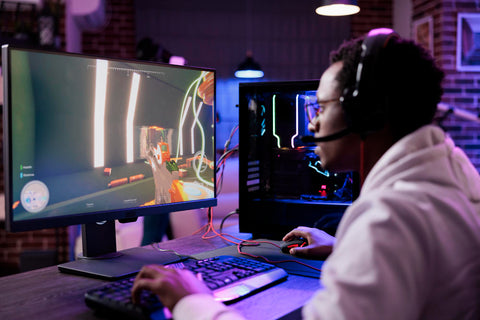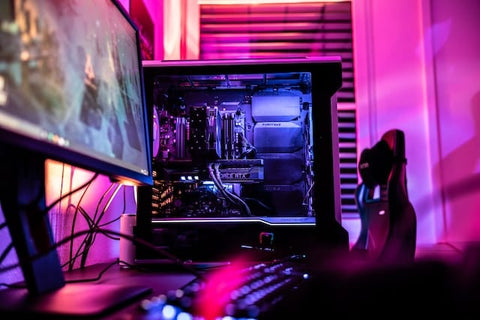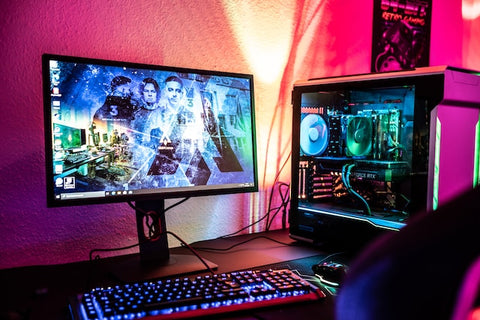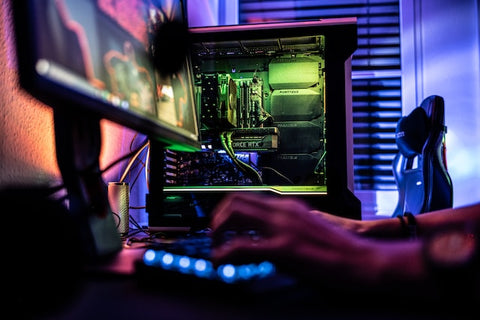
Overclocking is the process of changing the settings of your hardware to run at faster speeds than their default settings. The name comes from increasing the “clock” speed of these components, which in turn determines how many calculations they can perform per second.
When you buy a computer, it comes with certain settings that determine how fast its components, like the processor (CPU), work. Overclocking is the process of making these components run faster than their default settings. It's like giving your computer a little "boost" to make it work harder and faster.
By overclocking, you can make your computer perform tasks more quickly, such as running games or editing videos. It can give you a bit of extra power and improve your computer's performance without having to buy new, more expensive hardware.
However, it's important to know that overclocking also has some risks. When you make your computer work faster, it generates more heat, and this heat can damage the components if not properly managed. So, if you decide to overclock, you need to ensure that your computer has good cooling systems, like fans or liquid cooling, to keep it from overheating.
Additionally, overclocking can sometimes make your computer unstable, leading to crashes or freezes. So, it's important to test and find the right balance between speed and stability.
Many gamers like to test out their hardware by putting it through the paces of overclocking, mainly to improve the performance of each part and providing a faster gaming experience. Overclocking can also provide a solution to keep gaming at the same level without needing to purchase newer parts, providing a noticeable boost in speed and responsiveness, allowing for smoother gameplay, faster data processing, or shorter rendering times.
We’ve compiled our guide to overclocking, what to consider if you’re thinking
How to begin the process of overclocking

To overclock your computer, you typically need to adjust settings in the system's BIOS (Basic Input/Output System) or UEFI (Unified Extensible Firmware Interface). The exact steps can vary depending on your motherboard and BIOS version, but here is a general outline of the process:
Ensure proper cooling
Before overclocking, make sure your computer has adequate cooling. This includes a reliable CPU cooler, good airflow in the case, and proper ventilation. Overclocking generates more heat, so cooling is crucial to prevent overheating and potential damage.
Research your hardware
Understand the capabilities and limitations of your CPU, GPU, and other components. Consult the manufacturer's specifications and user guides to determine safe operating ranges for overclocking.
Access the BIOS/UEFI
Restart your computer and enter the BIOS/UEFI setup by pressing a specific key during the boot process (usually shown on the screen, such as F2, Del, or Esc). The key varies depending on your motherboard manufacturer.
Locate overclocking options
In the BIOS/UEFI settings, look for options related to overclocking. These can be labeled differently, such as "CPU Settings," "Performance," or "Overclocking." Specific options may include CPU multiplier, base clock, voltage settings, and memory frequencies.
Increase clock speeds
Begin by increasing the CPU multiplier or base clock in small increments (e.g., 0.5 GHz) and test the system stability after each adjustment. Monitor the temperatures using software like HWMonitor or Core Temp to ensure they remain within safe limits.
Adjust voltages
If necessary, adjust the CPU voltage to maintain stability at higher clock speeds. Increasing voltage can help stabilize the system but also generates more heat, so keep an eye on temperatures.
Stress testing
After making changes, stress test your system to ensure stability and verify that temperatures are manageable. Use programs like Prime95 or AIDA64 to stress the CPU and monitor temperatures and system behaviour.
Fine-tune and monitor
Continue adjusting clock speeds, voltages, and other settings incrementally until you find a balance between performance and stability. Regularly monitor temperatures and stability during extended periods of system use.
Test for stability
Run various applications, including games or resource-intensive tasks, to ensure your overclocked system remains stable under different workloads. Keep monitoring temperatures and stability during these tests.
Remember that every system is different, and there is no one-size-fits-all approach to overclocking. It requires experimentation, patience, and careful monitoring. Always prioritize the safety and stability of your system and be prepared to revert to default settings if instability or excessive heat occurs. If unsure, always consult a professional.
Pros of Overclocking

Increased performance
Overclocking can potentially boost the performance of your gaming PC, allowing for higher frame rates and smoother gameplay in some cases. This can be especially beneficial for resource-intensive games or applications.
Cost-effective performance upgrade
Overclocking can be a more cost-effective way to improve your PC's performance compared to buying new hardware. It allows you to extract more power from your existing components without investing in expensive upgrades.
Flexibility and customization
Overclocking provides you with the flexibility to fine-tune your system's performance based on your specific needs. You can adjust clock speeds, voltages, and other settings to achieve the desired balance between performance and stability.
Cons of Overclocking

Increased power consumption and heat generation
Overclocking typically requires pushing the CPU and other components beyond their default settings, resulting in higher power consumption and heat generation. This can strain your power supply and cooling system, potentially leading to increased energy costs and the need for more robust cooling solutions.
Reduced component lifespan
Overclocking increases the stress on your CPU, GPU, and other components. Running them at higher frequencies and voltages can shorten their lifespan. Over time, this could lead to component degradation or even failure, especially if proper cooling measures are not in place.
Stability issues and system crashes
When pushing your hardware to its limits, stability issues may arise. Overclocking can cause system crashes, freezes, or unexpected restarts, particularly if the settings are not properly optimized. Finding the right balance between performance and stability can be challenging.
Potential risks of Overclocking

Voided warranties
Overclocking often voids the warranties provided by manufacturers. If any component fails while overclocked, you may not be eligible for warranty claims or support.
Data corruption or loss
In extreme cases of instability, overclocking can lead to data corruption or loss. It is crucial to back up important files and data regularly to mitigate this risk.
Potential for damage
Overclocking carries the risk of damaging your hardware if done incorrectly or if the system lacks proper cooling. Excessive voltage or improper settings can cause irreversible damage to your CPU, GPU, or other components.
To minimize the risks associated with overclocking, it is essential to do thorough research, follow reliable guides or tutorials, and proceed with caution. Proper cooling, stress testing, and monitoring of temperatures are vital to ensure the stability and longevity of your system. Alternatively, you can get in touch with one of our professionals if you’re interested in overclocking or purchasing a system capable of overclocking.







